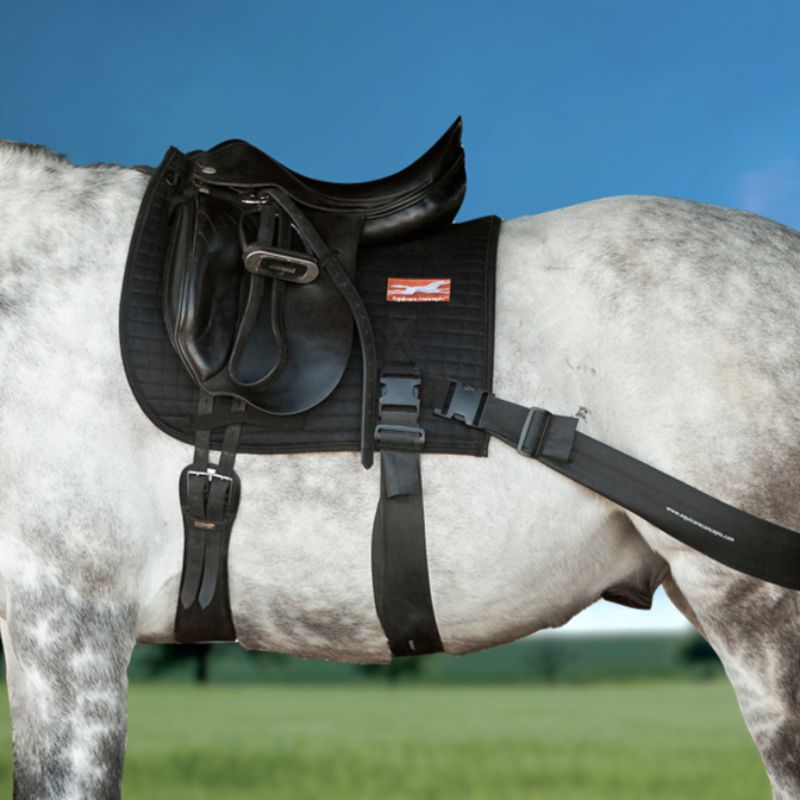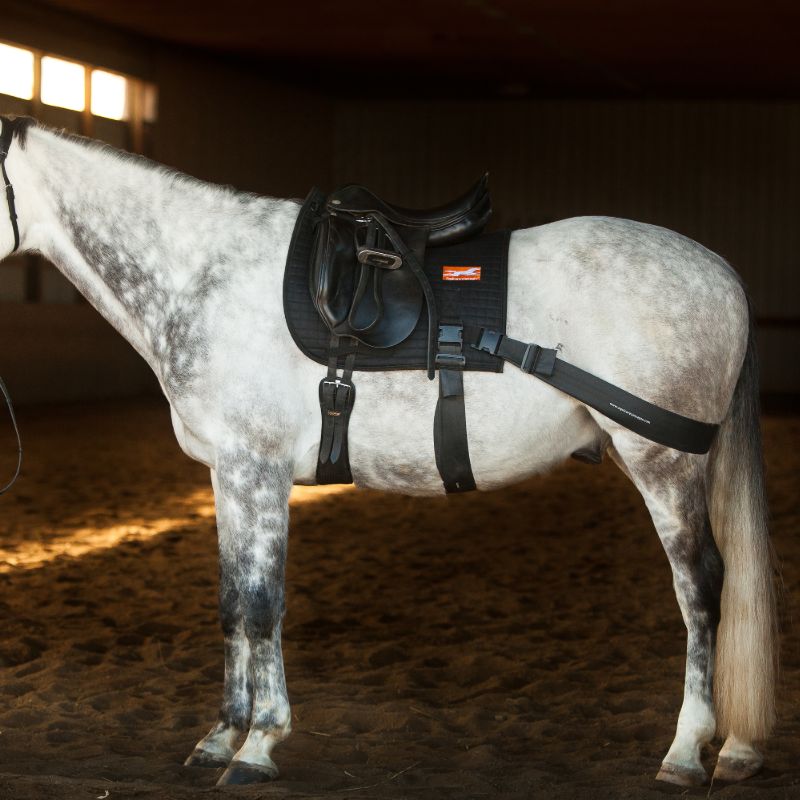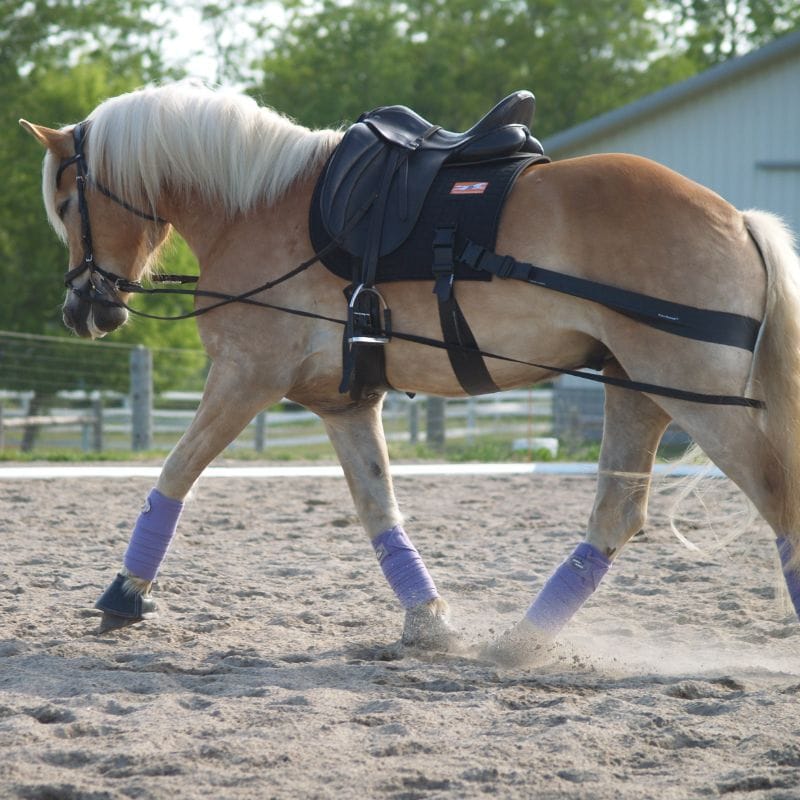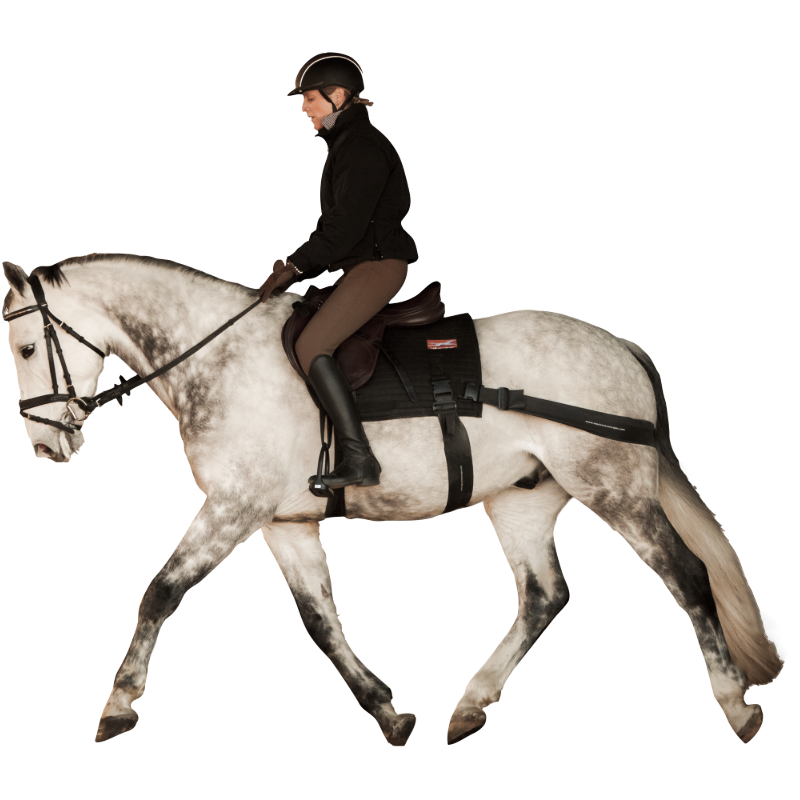COMPLETE EQUIBAND® SYSTEM
£235.00
Your Equiband® system comes complete with a saddle pad, two pre-threaded sets of Equiband® (two shorter abdominal bands and two longer hindquarter bands), as well as a tape measure and user guide. For safety, it is essential to follow the guide on how to fit and use the Equiband® system. For use with all types of English saddles or surcingle.
ABOUT - The Equiband® System
Your Equiband® system can be used during ridden or groundwork exercises. It comes complete with one saddle pad, two pre-threaded sets of Equiband® (two shorter abdominal bands and two longer hindquarter bands), as well as a tape measure and user guide. For safety, it is essential to follow the guide on how to fit and use the Equiband® system.
The Equiband® is made of a unique latex-free resistance band, specifically designed for use on horses. The Equiband® system uses either one or both bands on the horse.
Abdominal Band (AB):
The shorter band attaches the left side of the saddle pad to the right, passing under the abdomen. The band sits well behind the rider’s leg. Its function is to stimulate the abdominal and oblique musculature during locomotion. The abdominal musculature supports the horse’s back. The position of this band is especially indicated for horses that have recovered from a colic surgery, have poor (inverted) posture, and in clinical cases such as diagnosed conditions of the back, including ‘kissing spines’.
Hindquarter Band (HQ):
The second and longer Equiband® attaches at an oblique angle from the left side of the saddle pad to the right, passing under the tail, behind the horse’s hindquarters. It will settle in the point of least resistance, anywhere above the hock and just below the level of the stifle. Its function is to make the horse aware of the position of his hind limbs in locomotion and to enhance proprioception. Use of this band is especially indicated for horses with asymmetrical hind limb movement, poor engagement, and poor development of major muscle groups such as biceps femoris (which is associated with movement), as well as horses recovering from diagnosed musculoskeletal or neurological conditions (such as EPM).
Saddle Pad:
The saddle pad is available in multiple sizes to achieve optimal muscle activation for all breeds of horses and ponies. It is ergonomically shaped to prevent any restriction in the wither or lower back regions. The clips that attach Equiband® to the saddle pad are designed for durability and safety. The saddle pad is designed for use with jumping, dressage and western saddles, as well as surcingles.
How it Works: The Importance of Core Strength
Core musculature stabilizes the horse’s back in movement. Core strength helps to prevent the development of back pain and injuries. The Equiband™ system has been designed specifically to stimulate receptors in the horse’s skin and hair follicles.
In response to this stimulation, the abdominal, oblique, sublumbar and deep neck and back muscles are activated. These muscles stabilize the spine, and engage the hindquarters during movement.
Regular use of the Equiband™ system strengthens this core musculature, making it easier for the horse to work with an optimal posture, which reduces the risk of pain and injury due to hollowing or instability of the joints in the neck and the back.
The Equiband™ system (est. 2011) is a completely unique design that promotes continuous core activation during ridden, lungeing, or in-hand exercise. It is suggested for use with a programme of ground-based core activation and strengthening techniques, and only with veterinary and/or licensed therapist guidance.
The Core and More
The Equiband® system can be used on horses of any age or discipline, providing they are free of any undiagnosed lameness or neurological disorder. The Equiband® system is not a substitute for veterinary care, and when in doubt veterinary advice must be sought prior to using the Equiband® system.
The Equiband® system is indicated as ideal for:
- Young Horses
Use the Equiband® system when the horse is being trained in hand, on the lunge ,or with long lines/reins before the horse is introduced to work under saddle. The goal is to strengthen the core muscles in preparation for ridden work, and thus avoid potential injury due to weakness in early exercise under saddle. The Equiband® system should continue to be used once ridden work is introduced, but the frequency may be reduced to a couple of times a week once the horse is strong enough to carry himself and his rider in a consistently optimal posture. - Aged Horses
To maintain spinal stability and core strength. Horses should use the Equiband® system in addition to an appropriate program of ground-based core activation exercises. - Retraining
Every horse that is being brought back into work after a period of inactivity will benefit from 4-6 weeks of training with the Equiband® system to strengthen the core musculature, prior to recommencing ridden exercise. This is especially indicated for broodmares, and for overweight horses whose core muscle tone is underdeveloped - Rehabilitation
Horses that have been rested following an injury or colic surgery will benefit from core training exercises from the ground during the period of inactivity, followed by a 4-6 weeks of movement retraining with the Equiband® system. The system is specifically indicated for rehabilitation for horses with diagnosed Kissing Spine issues, and following colic surgery. - Athletic Performance
Expert riders have the skills to support their horses’ backs during work, but not every rider is able to produce this desired posture. The Equiband® system teaches the horse to round up through flexing the spine, and allows the rider to develop a feel for this ideal frame. The goal is for the rider to learn how to activate the core musculature independently. As the rider’s skills improve, the Equiband® system can be used less frequently.
IMPORTANT!
The Equiband system® is not a training tool or gimmick! The concept of its use for core strengthening and movement retraining in the horse is based on scientifically-researched and validated techniques used in human conditioning and rehabilitation and on results from peer-reviewed published studies of the use of the Equiband system® for equine core strengthening and movement retraining. These studies include the use of resistance bands in core muscle activation, along with individually-designed exercise programs by veterinarians and professional therapists.
Research
The Equiband® System improves the stability of the spine during walking and trotting
Findings from studies show that Equiband® has a positive effect on spinal stability in motion (back and pelvis), which is key for optimal athletic performance.
 Dynamic stability is the stability of the spine during movement. Two studies have been performed to measure the effect of the Equiband® System on the stability of the spine in horses, during walking and trotting exercises. Dynamic stability of the vertebral column is important to reduce risk of pain or injury from hollowing or instability of the back during exercise.
Dynamic stability is the stability of the spine during movement. Two studies have been performed to measure the effect of the Equiband® System on the stability of the spine in horses, during walking and trotting exercises. Dynamic stability of the vertebral column is important to reduce risk of pain or injury from hollowing or instability of the back during exercise.
The first study was performed by veterinary scientists at the Royal Veterinary College in the UK. Seven horses that were free from lameness and involved in training and competition at various levels, were recruited for a 4-week exercise program.
The exercise program consisted of fitting the Equiband® System with the abdominal and hindquarter bands at 30% of the maximum tension. All Equiband® exercise was performed at the beginning of the horse’s normal workout session for the indicated time, and exercises emphasized transitions between gaits.
- Week 1: In-hand work with the Equiband® for 5 minutes per day/ 5 days per week prior to the horse’s normal exercise routine
- Week 2: In-hand and ridden work with the Equiband® for 10 minutes per day/5 days per week at the beginning of the horse’s normal exercise routine
- Week 3: In-hand and ridden work with the Equiband® for 20 minutes per day/4 days per week at the beginning of the horse’s normal exercise routine
- Week 4: In-hand and ridden work with the Equiband® for 30 minutes per day/3 days per week
Three-dimensional spinal motion was recorded at the beginning of the study (baseline), and following the 4-week program (final). The measurements were collected with and without the Equiband®, with the horse trotting in-hand and on the lunge. The researchers found that with use of the Equiband®, horses had reduced spinal movements in the wither and mid-thoracic/lumbar regions (the area under and just behind where the saddle would sit). Following the 4-week exercise program, rotational movement in the withers and thoracic region decreased, while dorsoventral (up and down) movement of the thoracic spine increased.
The results of this study indicate that the Equiband® system reduces movement of the spine during trotting exercises, indicating an increase in dynamic stability.
Citation: Pfau, et al. 2017. Effect of a 4-week elastic resistance band training regimen on back kinematics in horses trotting in-hand and on the lunge. Equine Veterinary Journal
Read more: https://equicoreconcepts.com/research/
Fitting Guide
1. Desensitize the Horse to the Touch of Equiband®
Gently rub Equiband® across the horse’s abdominal and hindquarter regions on both sides, and under the tail.
2. Fit the First Band
For this stage, have a helper present. Fit the Equiband® slowly and carefully, with sufficient tension to not hang loose. Handwalk, jog and lunge the horse. Even sensitive horses will rapidly accustom to the sensation of Equiband®. Some horses will show more difference in back flexion with the abdominal band, and others will be more reactive to band around the hindquarters. To start, apply only one band at a time and repeat the same process when introducing the horse to a second band.
3. Adjust the Band for Optimal Tension
Adjust the tension of the band prior to mounting. Equiband® is delivered pre-threaded and is adjusted by shortening or lengthening the band below the safety clip band through the triglides (below the safety clips) that attach the band to the saddle pad. Excess can be trimmed using scissors.
To adjust for ideal tension, take the band to full stretch and reduce it to less than 50% stretch, which is an optimal tension for use of Equiband®. Using the tape measure supplied, measure the distance between the two clips on the pad (between left and right sides: either along the hindquarter region or under the abdomen). The clips on the actual band can then be measured at no less than half of the distance apart. For example, if the distance between the two clips on the pad (left to right side) is 1.00m, the clips on the band should be no less than 50cm apart. Excess tension will inhibit movement.
4. Handjog and/or Lunge the Horse Prior to Mounting
Before mounting, handjog and trot or lunge the horse. Have a helper present when mounting the horse for the first time after fitting Equiband®. Allow the horse to accustom to the feeling of Equiband® at walk before moving into trot or canter.
5. Adding or Adjusting Equiband®
To add or swap to second band repeat steps 1 and 2. Only fit Equiband® without the rider on the horse. Always dismount when adding or swopping Equiband® and have a helper present until the horse is fully accustomed to use of the Equiband® system.
6. Usage
The Equiband® system is intended for in-hand work, and during lungeing and riding. Use the Equiband® system at the start of a workout graduating to use for a full session. Ensure that the horse receives regular breaks as the increased engagement of the core musculature will cause earlier fatigue in work. If the horse appears unlevel with use of the Equiband® system, cease use immediately and seek veterinary evaluation and/or advice. Use Equiband® from the start of work, emphasizing transitions between and within gaits. Reduce full riding time by half as increased core muscle engagement may cause fatigue.
If the abdominal band slips back or if the hindquarter band rides up, check the tension – it is often too loose. For optimal postural fit, ask for an abdominal lift when fitting the abdominal band, and ensure that the horse is standing under itself with the hind legs when fitting the hindquarter band. Always use the band system at the start of a workout, and remove the bands if necessary. Do not add the bands after warm-up or during a riding/training session: this defeats the objects of neuromuscular stimulation. Neuromuscular activation is best achieved at the start of a session, particularly during the warm-up phase. We recommend use of the abdominal band before adding the hindquarter band.
Sizing
| PONY | fits up to 12hh/120cm pad dimensions: 20″ spine/16″ drop |
| SMALL | fits 12hh/120cm – 14.1hh/145cm pad dimensions: 21″ spine/18″ drop |
| REGULAR | fits 14.2hh/148cm – 16.2hh/165cm pad dimensions: 23″ spine/21″ drop |
| LARGE | fits over 16.3hh/168cm pad dimensions: 25″ spine/22″ drop |
Reviews
Reviews
Only logged in customers who have purchased this product may leave a review.












There are no reviews yet.